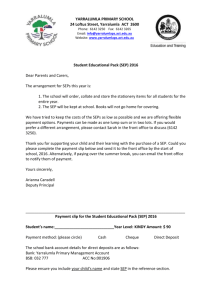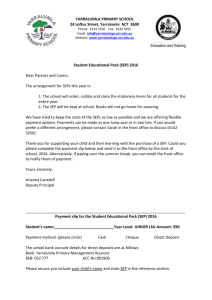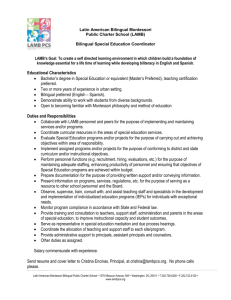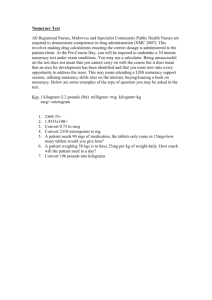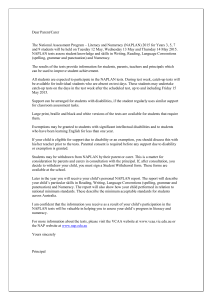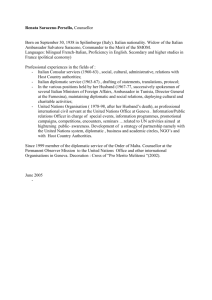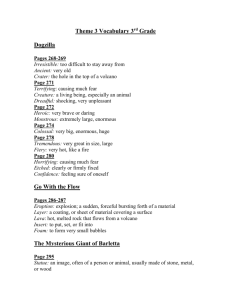Yarralumla Primary Annual School Board Report 2014
advertisement
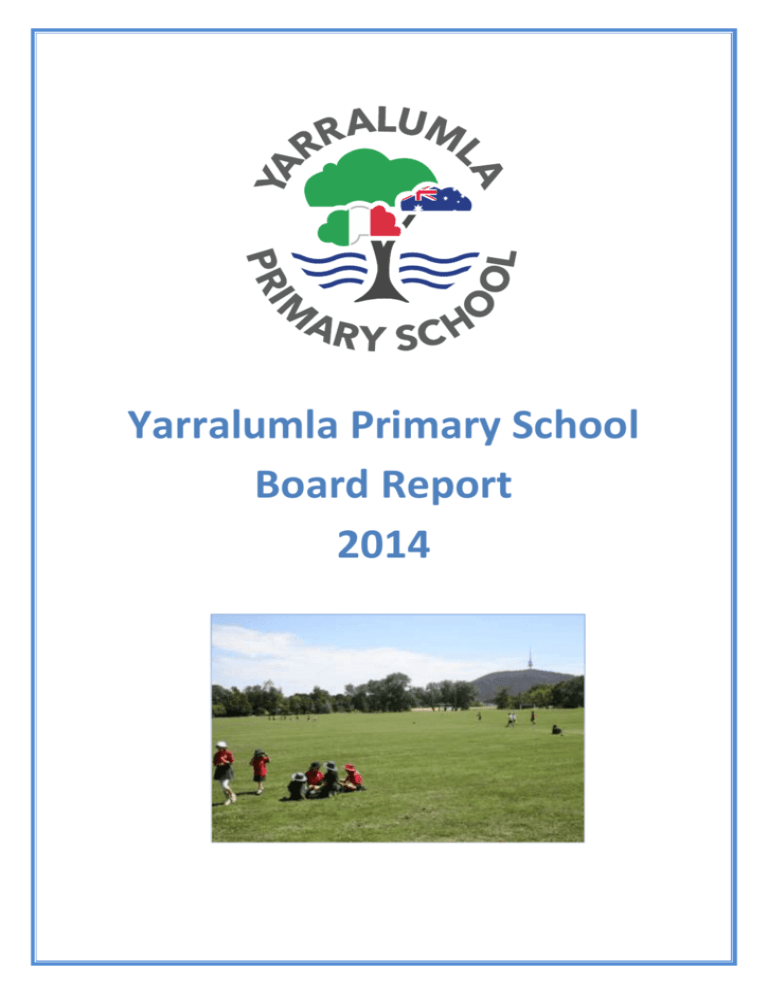
Yarralumla Primary School Board Report 2014 1 Yarralumla Primary Annual School Board Report 2014 This report supports the work being done in the ACT Education and Training Directorate, as outlined in the Strategic Plan 2014-2017 “Educational capital: Leading the Nation”. It complies with reporting requirements detailed within the Education ACT 2004 and the National Education Agreement. Accessibility The ACT Government is committed to making its information services, events and venues accessible to as many people as possible. If you have difficulty reading a standard document and would like to receive this publication in an alternate format, such as large print and audio, please telephone (02) 6247 4580. If English is not your first language and you require the translating and interpreting service, please telephone 13 14 50. If you are deaf or hearing impaired and require the National Relay Service, please telephone 13 36 77. © Australian Capital Territory, Canberra, 2014 Material in this publication may be reproduced provided due acknowledgement is made. The school website is http://www.yarralumlaps.act.edu.au. Inquiries about this publication should be directed to: Yarralumla Primary School Loftus St. Yarralumla ACT 2600 General Inquiries: Telephone (02) 6142 3265 2 Yarralumla Primary Annual School Board Report 2014 About our school Yarralumla Primary School is an English-Italian bilingual school enrolling children from the age of three in its Montessori Program to twelve years of age. It is located in a picturesque setting on the shores of Lake Burley Griffin. The school offers a range of specialised programs that comprise a kindergarten to year six Italian Bilingual program (50% of the week in each language), an English language focus class, an on-site preschool of two classes, a Montessori Cycle 1 program (for ages 3 to 6) and two Learning Support Units (autism specific). There is strong community support with up to 60% of enrolments coming from out of area due to demand for the bilingual program and the two autism units. Bilingual program students are taught the Australian Curriculum in both Italian and English; there is also a focus on The Arts and Sustainability. Introduction to School In 2014, the school’s enrolments continued to grow with the addition of a third kindergarten class and additional students enrolling in the bilingual program in years 1 to 6. The extra enrolments enabled an increase in the size of the executive staff to four positions to include the substantive position of an Italian Program coordinator appointed in Term 3. Student Information Student enrolment In 2014 there were a total of 349 students enrolled at this school, an increase of 26 students on 2013 enrolments. Table: 2014 Student Enrolment Breakdown Group Number of Students Male 172 Female 177 Indigenous LBOTE 6 124 Source: Planning and Performance, August 2014 Due to the Canberra community’s increasing awareness of bilingual language programs as an educational option for their children, the school continues to receive strong interest in its Italian Immersion Program from families outside the school’s Priority Enrolment Area. Enrolments grew by a full class to include a three stream kindergarten for the first ti. The school has also seen growth in student numbers from non-English speaking backgrounds due to its location in the embassy areas of Yarralumla and Deakin. 3 Yarralumla Primary Annual School Board Report 2014 Student attendance The following table identifies the attendance rate of students by year level during 2014. Student attendance rate is the percentage of school days attended by students in each year level at the school. Student attendance is measured over two school terms; that is from the first day of the school year for students in term one to the last day of term two. Table: 2014 Semester 1 attendance rates Year Level Attendance Rate % K 94.3 1 94.9 2 93.1 3 92.3 4 95.3 5 93.4 6 90.0 Source: Planning and Performance, July 2014 The school’s attendance rates have dropped from 95% average attendance in 2013 to 93% in 2014. This decrease may be explained by the lower figure in the Year 6 cohort where one family’s children were particularly affected by personal circumstances resulting in significant absences. This was followed through by the principal with regular phones calls, counselling support and continuation of procedures around student absences which include daily absence sheets completed by teachers, daily phone calls by the school secretary to parents of absent students, reminders in the newsletter about attendance and a letter from the principal to parents requesting an explanation of absences. There is strong parental support of these procedures. Staff Information Teacher qualifications All teachers meet the professional requirements for teaching in an ACT public school. The proportion of teaching staff with certificates/degrees/diplomas and a postgraduate qualification is shown below. Table: 2014 Qualification of Teaching Staff Qualifications Teaching staff (%) Certificate/Diploma/Degree 100 Postgraduate 40 Source: School Data, 27 February 2014 4 Yarralumla Primary Annual School Board Report 2014 Workforce Composition In 2014 the workforce composition of the school is highlighted in the following table. The data is taken from the school’s verified August pay report. For reporting purposes It includes all school staff including preschools if applicable, staff absent for a period of less than four consecutive weeks, staff replacing staff absent for more than four consecutive weeks. It does not include all casuals and staff who were not paid in this period and staff absent for a period of four consecutive weeks or longer nor unfilled vacancies. Table: 2014 Workforce Composition Numbers Role Total Administrative Service Officers 17 General Service Officers & Equivalent 1 School Leader A 1 School Leader B 1 School Leader C 2 Teachers 20 TOTAL 42 Source: Workforce Management, August census 2014 Note: This table includes pre-school staffing There are no indigenous staff at this school. In order to run the school’s bilingual program, at least seven out of the 20 teachers are required to be native Italian speakers. Further support is also provided by a permanent Italian Language Assistant and two Italian native speaking School Language Assistants (SLAs) from Italy who resided with Yarralumla families for at least three terms. Volunteers The estimated number of volunteer hours was approximately 2940 hours in 2014. The hours include significant periods of time spent by parents and grandparents of Yarralumla students assisting in the following ways: reading with students in class during the first 15 minutes of the day - Reading Hit teaching advanced maths to our gifted and talented students in Years 5 and 6 as part of CSIRO Education and Outreach’s Program - Scientists and Mathematicians in Schools program (SmiS) being a kindergarten Mystery Reader covering, cataloguing and stacking library books School Banking preparing food and serving in the school canteen on Fridays assisting with administrative tasks in the Front Office coordinating and coaching the school’s netball, tee ball and softball teams maintaining the school’s sustainable garden 5 Yarralumla Primary Annual School Board Report 2014 assisting with art lessons in the Art Studio assisting at sports’ carnivals and the Walkathon fundraising through stalls at the Multicultural Festival, P&C Social evening at the Italian Club and Italian Republic Day assisting with public relations at Open Day serving on the P&C and/or School Board School Review and Development In 2014, the ACT Education and Training Directorates Strategic Plan 2014-2017 provided the framework and strategic direction for the school’s plan. This is supported by the School Improvement in ACT Public Schools Directions 2010-2014 and the School Improvement Framework which are the overarching documents providing support to achieve high standards in student learning, innovation and best practice in ACT public schools. All ACT public schools participate in a four year cycle of school review and development. Schools take part in a continuous cycle of review comprising annual self assessments against their school plans. In the fourth year schools undergo an external validation process. This process provides an independent and unbiased assessment of the school’s progress towards achieving system and school priorities. Yarralumla Primary School will be validated in 2017. A copy of the most recent validation report (2013) can be found on the school website. School Satisfaction Schools continually use a range of data collection tools to gain an understanding of the satisfaction levels of their parents and carers, staff and students. In August/September 2014 the school undertook a survey to gain an understanding of school satisfaction at that time. Staff, parents and students from year 5 and above, with the exception of students in special schools were invited to take part in an online survey. Overall Satisfaction In 2014, 45 parents, 17 staff and 34 students responded to the survey. Where less than five responses were received the results were not reported due to concerns about participant privacy. In 2014, 87% of parents and carers, 100% of staff, and 71% of students at this school indicated they were satisfied with the education provided by the school. As well in 2014, 14 national parent survey items and 12 national student survey items were included in the surveys. These items were approved by the Standing Council on School Education and Early Childhood (SCSEEC) for use from 2014. The following tables show the percentage of parents and carers and students who agreed with each of the national items at this school. 6 Yarralumla Primary Annual School Board Report 2014 Table: Proportion of parents and carers in agreement with each national opinion item Item (%) Teachers at this school expect my child to do his or her best. 93 Teachers at this school provide my child with useful feedback about his or her school work. 82 Teachers at this school treat students fairly. 80 This school is well maintained. 84 My child feels safe at this school. 96 I can talk to my child’s teachers about my concerns. 82 Student behaviour is well managed at this school. 64 My child likes being at this school. 89 This school looks for ways to improve. 87 This school takes parents’ opinions seriously. 73 Teachers at this school motivate my child to learn. 84 My child is making good progress at this school. 80 My child's learning needs are being met at this school. 76 This school works with me to support my child's learning. 69 Source: 2014 School Satisfaction Surveys, September 2014 Table: Proportion of students in agreement with each national opinion item Item (%) My teachers expect me to do my best. 88 My teachers provide me with useful feedback about my school work. 82 Teachers at my school treat students fairly. 70 My school is well maintained. 82 I feel safe at my school. 88 I can talk to my teachers about my concerns. 38 Student behaviour is well managed at my school. 47 I like being at my school. 73 My school looks for ways to improve. 91 My school takes students’ opinions seriously. 53 My teachers motivate me to learn. 82 My school gives me opportunities to do interesting things. 94 Source: 2014 School Satisfaction Surveys, September 2014 This information can be considered alongside information available on the My School website (http://www.myschool.edu.au). 7 Yarralumla Primary Annual School Board Report 2014 These results as well as the continual review of school performance contributed to the evaluation of our school plan and the development of annual operating plans. The school plan is available on the school website. Professional Learning Aligned with the school’s 2014 Operating Plan, the focus of teacher Professional Learning in 2014 was on building teacher capacity with planning and incorporating the bilingual methodology CLIL (Content Language Integrated Learning) into the school’s Understanding by Design (UbD) curriculum template. This template also included a continued focus on developing students’ spelling skills (a focus in 2013) and improving students’ numeracy outcomes. Consequently the two days of January Professional Learning before the start of the 2014 school year was focused on teachers becoming more familiar with the Australian Curriculum (AC) content and capabilities, in particular, intercultural understanding and how to incorporate them with CLIL into the UbD planning template. Dr Tony Liddicoat from the Language faculty of the University of South Australia was engaged to present his research and pedagogical implications on CLIL and intercultural education for all teachers and Learning Support Assistants. Workshops were also run by the school’s Italian Program Coordinator and Deputy Principal on curriculum integration and developing an AC Scope and Sequence for our school’s bilingual context. Throughout the year, professional learning was conducted at staff, team and focus group meetings frequently led by the Executive Teacher Professional Practice in areas identified in the Teacher Register of Expertise. The ETPP has become a trainer in Count Me in Two and is leading the Junior team in more consistent maths pedagogy. In the senior classes, the emphasis has been on Middle Years Computation and developing comprehension skills with the structured Reading Comprehension Program - CARS (Comprehension Assessment of Reading Strategies) and STARS – (Strategies to Achieve Reading Success). Overarching these more specific areas of professional learning has been the embedding of Collaborative Conversations (CC) with all teachers observing one another teaching a literacy or numeracy lesson at least six times over the year, providing mutual feedback and documenting how their observations have informed changes in their practice. This CC approach has targeted areas of literacy and numeracy that teachers have self-identified as requiring further development and coaching by the school’s Executive Teacher Professional Practice who became an accredited GROWTH coach through the PL provided by the South Canberra/Weston Network grant. 8 Yarralumla Primary Annual School Board Report 2014 Learning and Assessment Performance in literacy and numeracy Early Years Assessment Students in kindergarten undertake an on-entry assessment of their early reading and numeracy skills using the Performance Indicators in Primary Schools (PIPS) program. Student results are reported against five performance bands at the end of semester one and two. The following table shows the comparison of the school against the ACT on raw scores in reading and mathematics. Table: Yarralumla Primary School PIPS 2014 mean raw scores Test Domain School Start School End ACT Start ACT End Reading 67 125 51 124 Mathematics 42 57 39 54 Source: Planning and Performance December 2014 This table demonstrates pleasing growth by the school’s kindergarten cohort especially in light of the fact that the cohort is taught in English for only 50% of the week. The focus is on phonics and concrete maths experiences in both languages. In term 1, as a result of the initial PIPs testing, those students identified at risk of achieving the end of year kindergarten reading benchmark were given early intervention support through extra tuition in small withdrawal groups throughout the year. A detailed analysis of our school’s academic achievement is incorporated into the information related to reporting against our progress against our priorities. This is found later in the report. NAPLAN Assessment Students in years 3, 5, 7 and 9 in all ACT schools participated in the National Assessment Program-Literacy and Numeracy (NAPLAN). This program assesses skills in reading, writing, spelling and grammar and punctuation and numeracy. In 2014, 2.70 % of year 3 students and 0.00 % of year 5 students were exempt from testing based on nationally agreed criteria. Results are not reported when there are fewer than five students with NAPLAN results. This rule is applied to protect the privacy of students in small schools. The following table shows the 2014 mean scores achieved by our students compared to the ACT. 9 Yarralumla Primary Annual School Board Report 2014 Table: Yarralumla Primary School 2014 NAPLAN Mean Scores Test Domain Year 3 School Year 3 ACT Year 5 School Year 5 ACT Reading 467 440 545 523 Writing 385 405 475 474 Spelling 411 413 508 502 Grammar & Punctuation 454 441 551 520 Numeracy 413 415 505 499 Source: Performance and Planning December 2014 The table shows at year 3 the school’s results were above that of the ACT in reading and grammar and punctuation while at year 5 they were above in all test domains. A more detailed analysis of our results can be found later in the report when we report against our priorities. Performance in other areas of the curriculum Participation and achievement in other areas of the curriculum by Yarralumla students include widespread participation in online programs such as Language Perfect in Italian, Mathletics, Spellodrome and Reading Eggs. Certificates are given out weekly at outside assemblies on Monday mornings to acknowledge student progress in these areas. In Years 4 to 6, students identified as requiring extension in maths were tutored by a mathematician from CSIRO’s Education and Outreach’s Program - Scientists and Mathematicians in Schools program (SmiS). Senior students also participated in the Gifted and Talented Da Vinci Challenge and all years 3 to 6 students participated in the mass choir of ‘Step into the Limelight’. To enhance students’ extra-curricular experiences, enrichment activities were offered every alternate Friday afternoon; these activities included pottery, dance, mosaic art, sustainable gardening, chess, digital media, drama and creative thinking. Progress against School Priorities in 2014 Priority 1 Improve student learning outcomes in English and Italian literacy and numeracy. Target/s By the end of 2014: increase NAPLAN school mean scores for literacy strands for all students to the ETD set targets specific to YPS continue to exceed ACT NAPLAN mean scores for numeracy strands for all students 10 Yarralumla Primary Annual School Board Report 2014 80% of students in bilingual program achieving A1 Standard of the Common European Framework of Reference for Languages (Italian) 80% of students in bilingual program achieving entry level in Italian language proficiency of the WIDA Language Development Standards continue to achieve 75% of Kindergarten students achieving Band 3 or above in PIPS numeracy and PIPS reading achieve outstanding rating for 50% of NQS elements in QA1 domain School improvement domains covered with this priority Teaching and Learning Progress There were six key improvement strategies implemented to address this priority. The first key improvement strategy was directed at reviewing and further developing the Italian Bilingual Program. The actions of this strategy included the following to meet our indicators of success: establishment of an Italian teachers Professional Learning Community led by an Italian Program Coordinator who was substantively appointed as a member of the Executive team at the beginning of semester 2 implementation of the Content and Language Integrated Learning (CLIL) bilingual pedagogy as the accepted best practice model for teaching bilingually; it is recognised internationally as the most credible pedagogy for bilingual settings and has been incorporated into the school’s use of the curriculum online planning tool of Understanding by Design implementation of the A1 and A2 assessment tasks of the Common European Framework Reference for Languages (CEFR) tool to provide a baseline benchmark of student achievement in both the receptive and productive modes of Italian. Staff and parental satisfaction with the Bilingual Program has been high with 89% of all staff, 88% of students and 82% of parents expressing their satisfaction with learning outcomes of students in this program. The second key improvement strategy was to develop sustainable practices in numeracy across the school. Actions of this strategy included: establishment of a School Improvement Numeracy Focus Group led by the Executive Teacher Professional Practice (ETPP) audit of all numeracy resources in the school implementation and staff professional learning by the ETPP on Mental Computation warm up games and strategies for all classes survey of all teachers on their numeracy practices numeracy practices were targeted for observation and feedback in teachers’ Collaborative Conversations professional learning. 11 Yarralumla Primary Annual School Board Report 2014 An indicator of success in this area is that all teachers have received professional learning in mental computation strategies from the Executive Teacher Professional practice (ETPP). In 2015, the Numeracy Focus group will be embedding a scope and sequence of numeracy benchmarks for students to achieve at each year level and will use the school’s identified database / spreadsheet application to track student progress in numeracy. The third key improvement strategy was to embed a culture of data analysis and data systems. The action items to implement this strategy have included the following: a School Improvement Data Focus Group established in term 1 - coordinated by the principal and an early childhood executive teacher that met twice a term a review of the student assessment schedule to determine what is doable and practical in a bilingual setting where most teachers assess two classes of students investigation at other school sites of possible databases and numeracy tracking systems; these have included GradExpert at Curtin PS, Accelerus at Harrison School, an online demonstration of the application Sentral and an Excel spreadsheet model at Hawker PS participation by executive in Professor Lyn Sharratt’s Professional Learning on building teacher capacity using data (and data walls) to determine their suitability for Yarralumla PS. consistent teacher use of the following data sets to identify students at risk of achieving benchmark in English and Maths : PIPS, PM Reader benchmarks, SENA 1 & 2, Bee Spelling, First Steps writing stages and samples. These students have received intervention through small withdrawal groups for phonics and/or maths. In terms of the target of 80% of students in bilingual program achieving entry level in Italian language proficiency of the WIDA Language Development Standards, this was not met. It was decided to postpone the introduction of this Italian language assessment tool as it became clear that the Italian teachers needed more time to build their knowledge of how to use the CEFR (Common European Framework Reference) tool for language assessment of students’ four language micro skills of reading, writing, listening and speaking. It will be introduced in 2015. The fourth key improvement strategy was to embed sustainable literacy practices across the school. Action items to address this were the following: implementation of consistent teacher spelling pedagogy across all grades through coaching by the ETPP including the introduction of spelling journals embedding of a whole school case management model for support of students with special learning needs, particularly in literacy early identification of students at risk and the continuation of intervention programs such as phonics groups each morning integration of Learning Support Unit students in the morning literacy rotations in early childhood classrooms. 12 Yarralumla Primary Annual School Board Report 2014 The emphasis last year and this year on establishing and improving consistent spelling practices is demonstrating an upward trend with the Year 3 results being on a par with ACT students and the year 5 result significantly above the ACT mean. Unfortunately our junior school teachers’ decision to focus on the narrative genre of writing in preparation for NAPLAN was to our students’ detriment as the persuasive genre was once again tested. Whilst students did do some preparation in the persuasive genre (and in both languages), as Yarralumla students do English for only half the week, this was reflected in the year 3 writing results. The year 5 writing result was on a par with the ACT mean. Table: Yarralumla PS NAPLAN Literacy Mean Scores Year level Reading Writing Spelling Grammar & Punctuation YPS Year 3 467.3 384.6 410.5 453.8 ACT mean 440.1 405.1 413 441.3 Network mean 463.3 414.8 424.4 461.6 YPS Year 5 545.3 475.1 508.4 551.1 ACT mean 522.8 474.3 502.5 519.8 Network mean 542.9 488.3 517.1 541.4 Source: SMART data, January 2015 The grammar and punctuation results for years 3 and 5 are also above the ACT mean, with the year 5 cohort being above the network mean. Another indicator of success of our school’s literacy strategies is the figure of 89% of students in year 1 and 93% in year 2 who are at or above the Australian Curriculum English achievement standard. For those students with ILPs and PLPs, the use of the SCERTS (Social Communication, Emotional Regulation, Transaction Support) resource by the Special Education teachers has enabled more targeted support of students in achieving the SMART goals identified in their ILPs. The fifth key improvement strategy was to implement the Australian Curriculum (AC) learning areas with greater focus on the capabilities and cross curriculum priorities. Action items associated with this strategy include the following: all teachers are using the online Understanding by Design (UbD) planning tool to develop their inquiry units based on the AC learning areas of science, history and geography and integrated with English, maths and CLIL bilingual pedagogy; a new scope and sequence model and timetable structure is being trialled as a semester unit harmonising all learning areas of the AC and aligning key concepts under an inquiry unit’s key understanding or big idea; Italian language is being taught through more 13 Yarralumla Primary Annual School Board Report 2014 practical hands-on subjects such as science, geography and sustainability practices whilst history and more complex concepts are being taught through English professional learning for teachers this year has focused on building their understanding of the breadth of the Australian Curriculum, in particular the humanities and social sciences; two days for all staff were designated for learning to navigate the new content and capabilities of the AC website and integrating content into a Kindergarten to Year 6 scope and sequence of inquiry units staff have focused on integrating the cross curriculum priorities and capabilities more effectively across all year levels; a particular focus on the capabilities at the beginning of the year was on intercultural understanding delivered through Italian language as well as English and emphasised through CLIL integration of learning technologies as a learning tool for students on a daily and ‘just in time’ basis is more evident in classrooms through equitable allocation of ICT devices such as visualisers in each classroom to enhance the use of Interactive White Boards, headphone sets, the use of sets of ipads allocated to each classroom, a Macbook laptop trolley regularly on loan and the use of innovative multimedia applications to engage students in more inquiry and independent learning. Indicators of success are that all teachers use the UbD planning tool to ensure rigorous alignment of formative and summative assessment tasks with learning and teaching goals. Strategies for students’ intercultural understanding, digital learning paths and other capabilities are demonstrated by all teachers on their UbD curriculum documents from Kindergarten to Year 6, including the Learning Support Units. The sixth key improvement strategy was to implement the elements of QA1 of the National Quality Standard for Yarralumla’s two Early Childhood units. Actions against this strategy include the following: professional learning by Jill Vizec of the Montessori Children’s Foundation in St Kilda for the Montessori teachers and assistants conducted at the beginning of the year on how to further align The Early Years Learning Framework (EYLF) with the Montessori philosophy preschool villa students are engaging in sustainable environmental practices supported by Green Gang students from mainstream K-6 classes the review and development of a comprehensive reporting process for Yarralumla Montessori will be carried over into 2015 Overall our results against our specified targets for this priority are as follows. 1. The school’s met the NAPLAN target set by the Directorate for both years 3 and 5 with the schools’ results being above the target but not significantly when considering the confidence intervals. (See table below) This is testament to the success of the Reading Hit strategy for 15 minutes every morning in all classrooms across the school. It also endorses the success of continued teacher focus on the First Steps Reading program since its introduction in 2012. 14 Yarralumla Primary Annual School Board Report 2014 Table: NAPLAN Reading Mean against ETD Targets Year Target Actual 3 441 ± 28 467.3 5 539 ± 28 545.3 Source: SMART data January 2015 2. The numeracy target for this year to achieve above the ACT mean was not achieved for all year 3 students but was achieved by year 3 boys (17 points above their ACT cohort) whilst year 3 girls’ results indicate they require further intervention and support to meet the ACT mean. The continued focus by teachers on mental computation and consistent numeracy practices across the school including the introduction of the maths online resource - MTS should help address this. Year 5 all students achieved the target of achieving a greater mean score than the ACT. This was supported by the year 5 girls being 21 points above their ACT cohort. Year 5 boys achieved similar results to their ACT cohort. The Australian Curriculum Assessment and Reporting Authority listed Yarralumla Primary in the top 20 ACT schools for above average growth in numeracy from Year 3 by our Year 5 students. Table: NAPLAN Numeracy mean scores Group School ACT Year 3 All students 413.2 415.1 Year 3 Boys 437.7 420.2 Year 3 Girls 396.4 410.0 Year 5 All students 505.2 498.7 Year 5 Boys 496.9 504.9 Year 5 Girls 513 492.2 Source: SMART Data January 2015 3. The school met its target of 80% of students reaching the A1 standard of CEFR. The A2 standard was also assessed in two of the senior classes with one of the classes demonstrating the pleasing result of 100% of students achieving A2 standard in listening, 88% achieving A2 in reading and 85% in writing. 4. In Kindergarten, the 2014 PIPs results indicate that the school has continued to achieve 75% of its students achieving Band 3 and above in numeracy and reading. 5. We cannot report against the target related to NQS accreditation in 2014 due to YPS not being scheduled for assessment. More detail about the Early Childhood programs in the Montessori and preschool villas is included in the final section of this AOP Report. 15 Yarralumla Primary Annual School Board Report 2014 Priority 2 Strengthen inspirational teaching and leadership: improve teaching and leadership capacity Targets By the end of 2014: 50% of teachers are coaching and mentoring colleagues across the school or network 50% of ratings (for the expert teaching team domain) are high and/or outstanding in the National Improvement School Improvement Tool 100% of teachers meet the National Professional Standards for teachers 100% of teaching staff are satisfied they are receiving regular and timely feedback about their practice from colleagues and executive at least one member of each teaching team performs higher duties at executive level and/or is promoted to a substantive promotional position School improvement domains covered with this priority Leading and Managing, Teaching and Learning Progress There are two Key Improvement Strategies to address this priority. The first key improvement strategy was to embed a culture of reflective practice through coaching and mentoring. Action items to address this were as follows: all teachers undertook six Collaborative Conversations that have been aligned with their identified needs in the YPS Register of Teacher Expertise (collated by the ETPP) in order to be more specifically targeted about their practice the ETPP conducted fifteen one hour coaching conversations related to teachers’ identified practice needs with targeted staff. The ETPP also conducted GROWTH coaching sessions with three staff throughout the year towards her accreditation as a GROWTH coach Italian teachers’ collective capacity was enhanced by the leadership of the new Italian executive teacher who provided professional learning in the CLIL pedagogy the appointment of the new Italian Program coordinator expanded the capacity of the leadership team and developed her own capabilities as a coach, mentor and leader The second key improvement strategy was to improve induction processes for new staff to ensure consistency of practice and expectations. Actions that were undertaken to address this include: a formal induction process was developed towards the end of the year in collaboration with two teachers who participated in the 5 day ACT Mentoring Program. This process will be implemented at the beginning of 2015 and evaluated via mentees’ formative and summative feedback. the staff handbook is regularly updated for all new staff. In respect of our targets the following provides evidence of success: 16 Yarralumla Primary Annual School Board Report 2014 100% of teachers are coaching and mentoring one another through the Collaborative Conversations process the domain of expert teaching team in the National School Improvement Tool was rated as high by more than 50% of staff all teachers have received professional learning on the seven National Professional Standards for teachers The Australian School Climate and School Identification Measurement Tool (ASCSIMT) demonstrated that 100% of staff reported excellent to adequate levels of professional development opportunity and emphasis (this included staff receiving quality feedback on their performance); this result was greater than the ACT average of 98.7%. capacity of the teaching team has been enhanced by three staff performing higher duties for periods varying from a week to a semester, one of whom was appointed substantively to SLC (Italian Program Coordinator) Priority 3 Enhance student and community engagement Targets By the end of 2014: increase by 20% positive student responses relating to wellbeing and safety in the Friendly Schools Plus school survey increase by 10% the number of positive responses in School Parent Satisfaction survey relating to ‘community partnerships are valued and maintained’ increase by 10% positive responses in School Student Satisfaction survey result relating to ‘student behaviour is well managed at my school’ increase by 20% the number of ‘mostly true’ staff responses in the National Safe Schools Framework Audit Tool School improvement domains covered with this priority Student Engagement and Community Involvement Progress There are two Key Improvement strategies for this priority. The first key improvement strategy was to develop processes and practices that support student engagement and wellbeing. Action items to address this were as follows: embedding of the school’s 3i values, the Fish Philosophy and the Friendly Schools Plus Social and Emotional Learning Program (SEL) introduced in 2013; the employment of Restorative Practices as a tool for resolution of conflict is also customary practice for executive and teaching staff the practice of Mindfulness was introduced for all K-6 children with anecdotal evidence from students and teachers that it has helped student self-regulation, makes them calmer and also more energised after playtime for deeper learning 17 Yarralumla Primary Annual School Board Report 2014 students have been given multiple opportunities to demonstrate leadership in various school activities and events that include being ‘Ambassadors’ at the school’s Open Day, the Minister’s visit, the school stall at the Canberra Multicultural Festival, Italian Republic Day, book week rotation activities, fundraisers, buddy support to younger classes, sports equipment and team leaders at sporting carnivals the National Safe Schools Framework Audit tool was adopted as an audit tool for the Executive and will be circulated to all staff for tracking in 2015 a model for online learning for graduates of Yarralumla Primary did not eventuate in 2014 due to the delayed implementation of the video conferencing facility and subsequent training of staff in mid-term 4; this will be a priority in the 2015 Action Plan. Indicators of success against the targets for this priority are that 88% of Yarralumla Primary students indicated in the School Satisfaction Survey say that they feel safe and 96% of parents believe their child is safe. In relation to the perception that student behaviour is well managed at the school, in 2014 parent perception has dropped by 8 percentage points from the previous year’s results while students’ responses have increased by 4 percentage points. This is an area the school will continue to work on through teacher focus on weekly Friendly Schools Plus lessons and on school values. The second key improvement strategy was to improve processes and the number of opportunities for engagement with parents and the wider community. Action items to address this were as follows: A strong partnership was forged between YPS and the cluster of schools in Bergamo, northern Italy initially through the September/October biennial language program in-country community trip. This involved 17 students being billeted with Italian families at three local schools and links being made with their local Italian secondary schools to attract teachers for exchanges - not only with YPS but also our feeder high school, Alfred Deakin High where Italian has now been established as a language option. Two staff members accompanied families on this trip and a Memorandum of Understanding was established between the Italian principal and YPS principal for all future exchanges. It is likely that the community trip will become an annual event due to strong interest and very positive feedback from the participants. At least two YPS staff members attended the three Victorian Bilingual School network meetings to share bilingual pedagogical practice and garner interest in Yarralumla’s model. Our school has been included in a national survey of bilingual schools as part of a University of Melbourne research study on bilingual schools. The principal and Italian executive teacher attended the Italian Ambassador’s ‘Italians Down Under’ conference and contributed to the discussions and identified ways forward for the promotion of Italian language and culture. 18 Yarralumla Primary Annual School Board Report 2014 A high level of parental involvement in three of the school’s main community events: the school board sponsored stall at the Multicultural Festival, the P&C fundraising Social evening and the Yarralumla Community Twilight Market. A volunteer letter outlining possibilities of how parents can volunteer time or talents in or out of classrooms and via a classroom parent contact helped raise the profile of volunteering and the numbers of parents, grandparents and carers who volunteer. Yarralumla Primary continues to be well represented at local association netball and tee ball Saturday morning competitions. In 2014, we had five netball teams in the winter competition and four tee ball/softball teams compete over the 2014/15 summer. The School Satisfaction Survey results indicate that 84% of parents/carers believe that community partnerships are valued and maintained. In the ASCSIMT survey, 100% of parents self-reported excellent to adequate levels of involvement with the school. A final indicator of success is that double the number of families participated this year in the school’s biennial in-country language program compared with the representation in 2012. Preschool Units- Quality Improvement in the Montessori and Preschool Villas The National Quality Framework, which has been agreed by the Council of Australian Governments (COAG), has put in place a new National Quality Standard to ensure high quality and consistent early childhood education and care across Australia. The National Quality Standard assists the school in identifying preschool unit strengths, and areas that require improvement. The school has identified the following preschool unit strengths using the National Quality Standard. Areas for improvement will be identified in the School’s Operating Plan. Neither early childhood villa was assessed for accreditation in 2014. However both received a feedback visit from the Children’s Policy and Regulation Unit and based on their Quality Improvement Plans, Operation Manuals and programs, they are well placed for accreditation in 2015. Education program and practice The curriculum in both the Montessori and preschool villas is relevant to children’s interests, identity, wellbeing, culture and past experiences and builds on their effectiveness as communicators. Equal emphasis is placed on the indoor and outdoor programs, the latter being provided in a large, natural landscape with plentiful challenging equipment and collaborative play areas such as a mud kitchen, dry creek beds and rock gardens. Children’s play is documented and extended to cater for diverse interests. Yarralumla Montessori staff have established professional links with Montessori qualified staff in Canberra, Sydney and Melbourne in order to further promote the integration of Montessori practices and the 19 Yarralumla Primary Annual School Board Report 2014 Early Years Learning Framework. Preschool staff have once again liaised frequently with other Directorate preschool staff through professional learning and visits to other preschools. Children’s health and safety Initial parent/teacher interviews provide the opportunity to identify children’s interests and health needs. The correct student-staff ratios are maintained, staff have appropriate first aid qualifications and risk assessments are undertaken for excursions. The children are provided with privacy when toileting and daily relaxation time, rest and quietness is factored into the daily routine. Relationships with children Interactions and relationships with children are warm, welcoming, respectful, professional and ethical. Collaborative opportunities are provided within the programs and children are actively supported in managing their behaviours and in developing reflective thinking skills. Staffing arrangements This is the second year of operation with two preschool groups taught by two separate teachers in the same unit at opposite ends of the week. The same LSA supports these two teachers and all staff receive the appropriate amount of release time from face to face teaching and sufficient planning time together for the development of the program. Leadership and management For the first half of this year, the early childhood executive teacher was the supervisor of the preschool program. Due to his retirement in semester 2, this role was taken over by the deputy principal in the preschool and the principal in the Montessori villa. Meetings are fortnightly and minutes of meetings are taken. Physical environment The resources and grounds of both villas are suitable to the needs and safety of early childhood children. Major re-furbishments in 2013 and redoing the soft fall around the rock garden has ensured the children have a safe, exciting and innovative outdoor area to explore. Collaborative partnerships with families and communities Staff in both villas work closely with their respective parents in developing collaborative partnerships. There is a preschool representative on the P&C and the Montessori Parent Association has a non-voting representative on the school board. This year, both sets of parents and staff liaised cooperatively to plan an inaugural combined Early Childhood Villa Spring Fair. Previously both associations had run this fundraising enterprise separately, so it was a significant step forward in being inclusive of all interests to have this combined fair. Over $7000 was raised as a result of their collaborative effort and these proceeds will be shared by the two villas to purchase equipment and resources. 20 Yarralumla Primary Annual School Board Report 2014 Financial Summary The school has provided the Directorate with an end of year financial statement that was approved by the school board. Further details concerning the statement can be obtained by contacting the school. The following summary covers use of funds for operating costs and does not include expenditure in areas such as permanent salaries, buildings and major maintenance. Professional learning Financial Summary 31-Dec-14 The average expenditure at the school level per fulltime equivalent teacher on professional learning was $1665. This school received $24,560 in voluntary contributions in 2014. These funds were used to support the general operations of the school. The spending of voluntary contributions is in line with the approved budget for 2014. Vol untary contri buti ons Contri buti ons & donati ons $3000 Expected Completion December 2014 101,980.56 9767.41 458956.49 Bank Interes t TOTAL INCOME EXPENDITURE Uti l i ti es and general overheads Cl eani ng Securi ty Mai ntenance 81911.03 76028.33 1507.76 77743.48 Mandatory Mai ntenance OPERATING RESULT 33101.13 0 8325.05 54788.94 12348.72 25232.89 51186.67 2181.82 424355.82 34600.67 Actual Accumul ated Funds 217613.11 Staffi ng Amount 276564 24560 30199.02 15885.5 Proceeds from s al e of as s ets Admi ni s trati on Reserves To provide a colour A3 photocopier for administrative and educational use. Sel f management funds Subj ect contri buti ons External i ncome (i ncl udi ng communi ty us e) Voluntary contributions Name and purpose INCOME Communi cati on As s ets Leas es General offi ce expendi ture Educati onal Subj ect cons umabl es TOTAL EXPENDITURE Outs tandi ng commi tments (mi nus ) 74566.7 BALANCE 177647.08 21 Yarralumla Primary Annual School Board Report 2014 Endorsement Page I declare that the Yarralumla Primary School Board has operated in accordance with the provisions of the Education Act 2004 including the following sections. 39 (4) The school board must give effect to the chief executive’s directions. 44 (2) The chief executive must end the appointment of a member of the school board of a public school, other than the principal of the school ifa) The member is absent from 3 consecutive meetings of the board without reasonable excuse or leave given by the board or b) Contravenes section 49 (disclosure of interests by members of school boards) without reasonable excuse. 46 47 (2) The members of the school board of a public school must, whenever is necessary, nominate a member of the board as a member of any selection panel established by the chief executive to make recommendations to the chief executive about the appointment of the principal to the school. However, the school board must meet at least four times a year. 48 (10) The school board must keep minutes of its meeting. 49 Disclosure of interests by members of school boards. 49 (3) The disclosure must be reported in the school board’s minutes and, unless the board otherwise decides, the member (The first member) must nota) be present when the board considers the issue or b) take part in any decision of the board on the issue. 49 (5) Within 14 days after the end of each financial year, the chairperson of the school board must give the chief executive a statement of any disclosure of interest under this section in relation to the school board during the financial year. MEMBERS OF THE SCHOOL BOARD Parent Representative: Community Representative Teacher Representative Board Chair: Principal: Rachel Smith-Cianchi John Wynants Cheryl Couch, Lynden Lawton Debbie Hicks Lea Chapuis I certify that to the best of my knowledge and belief the data and information reported in this Annual School Board Report represents an accurate record of the school’s operations in 2014. Principal Signature: _________________________ Date: _____________ I approve the report, prepared in accordance with the provision of the ACT Education Act, section 52. Board Chair Signature: __________________________ Date: ____________
